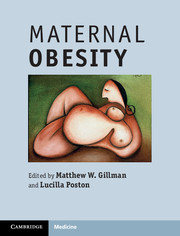Crossref Citations
This Book has been
cited by the following publications. This list is generated based on data provided by Crossref.
Zambrano, Elena
and
Nathanielsz, Peter W
2013.
Mechanisms by which maternal obesity programs offspring for obesity: evidence from animal studies.
Nutrition Reviews,
Vol. 71,
Issue. ,
p.
S42.
Poston, Lucilla
and
Patel, Nashita
2014.
Dietary recommendations for obese pregnant women: current questions and controversies.
Acta Obstetricia et Gynecologica Scandinavica,
Vol. 93,
Issue. 11,
p.
1081.
Kim, Jin Kyu
Nam, Hajin
Kim, Yoo Yeon
Jung, Harry
Choi, Yoon Soo
Oh, Joa Sub
Chun, Su Kyoung
and
Suh, Jun Gyo
2015.
Anti-adipogenic effects in 3T3-L1 cells of acetone extracts and fractions from Styrax japonica fruit.
Food Science and Biotechnology,
Vol. 24,
Issue. 4,
p.
1513.
Vega, C C
Reyes-Castro, L A
Bautista, C J
Larrea, F
Nathanielsz, P W
and
Zambrano, E
2015.
Exercise in obese female rats has beneficial effects on maternal and male and female offspring metabolism.
International Journal of Obesity,
Vol. 39,
Issue. 4,
p.
712.
Darnton-Hill, Ian
and
Mkparu, Uzonna
2015.
Micronutrients in Pregnancy in Low- and Middle-Income Countries.
Nutrients,
Vol. 7,
Issue. 3,
p.
1744.
Mullins, E
Murphy, O
and
Davies, SC
2016.
Pre‐conception public health to address maternal obesity.
BJOG: An International Journal of Obstetrics & Gynaecology,
Vol. 123,
Issue. 2,
p.
159.
Zerf, Mohammed
2017.
Obesity degrees and their relationships with weakness of musculoskeletal system among the obese housewife.
Saudi Journal of Sports Medicine,
Vol. 17,
Issue. 1,
p.
7.
Hawkins, Summer Sherburne
Oken, Emily
and
Gillman, Matthew W.
2018.
Handbook of Life Course Health Development.
p.
169.
Dalrymple, Kathryn V.
Thompson, John M.D.
Begum, Shahina
Godfrey, Keith M.
Poston, Lucilla
Seed, Paul T.
McCowan, Lesley M.E.
Wall, Clare
Shelling, Andrew
North, Robyn
Cutfield, Wayne S.
and
Mitchell, Edwin A.
2019.
Relationships of maternal body mass index and plasma biomarkers with childhood body mass index and adiposity at 6 years: The Children of SCOPE study.
Pediatric Obesity,
Vol. 14,
Issue. 10,
Syböck, Katharina
Hartmann, Beda
and
Kirchengast, Sylvia
2023.
Maternal Prepregnancy Obesity Affects Foetal Growth, Birth Outcome, Mode of Delivery, and Miscarriage Rate in Austrian Women.
International Journal of Environmental Research and Public Health,
Vol. 20,
Issue. 5,
p.
4139.



